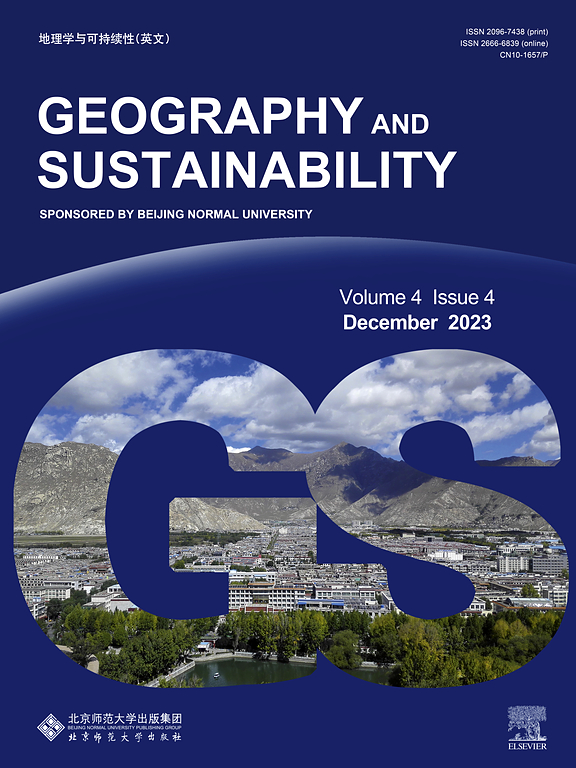基于自然的解决方案在城市规模实施中对热量缓解、能源使用和碳节约的影响
IF 8
1区 环境科学与生态学
Q1 GEOGRAPHY, PHYSICAL
引用次数: 0
摘要
城市化导致的土地覆盖和能源利用的广泛变化导致城市热条件的不平衡,使城市更容易受到气候变化的影响。基于自然的解决方案(NbS)利用绿地的冷却效应来缓解城市热量,作为面对气候变化提高城市可持续性的一种方式,正受到人们的关注。本研究利用生态系统服务与权衡综合评价(InVEST)城市降温模型(UCM),评估了NbS在城市尺度上对减热能力、气温、制冷能量、碳排放和碳固存的影响,以及由此产生的经济效益。绿色屋顶作为建筑适应性,土地利用适应性,如城市公园和路边绿地的扩展,森林恢复,以及建筑和土地利用适应性的组合,被认为是适用的NbS。还研究了冷屋顶,将其与其他城市绿色基础设施的效果进行比较。结果表明,在适用区域足够的情况下,同时实施多种适应方法是最有效的。从实施面积比来看,城市公园是最有效的单一适应性措施,其节能效果分别是100%绿化屋顶、凉爽屋顶和20%路边绿地扩展的14.75倍、8.63倍和1.98倍。恢复森林(21.29平方公里)的节能效果是安装100%绿色屋顶(62平方公里)的4.7倍。相比之下,砍伐森林损失的能量和碳比凉爽屋顶所能节省的要多。本研究有助于为实现城市碳中和提供一个适当的策略,即通过NbS减少碳排放和增加碳固存,同时降低城市温度。本文章由计算机程序翻译,如有差异,请以英文原文为准。

Effects on heat mitigation, energy use, and carbon savings in urban-scale implementations of nature-based solutions
Extensive changes in land cover and energy use resulting from urbanization lead to an imbalance in urban thermal conditions, making cities more susceptible to the impacts of climate change. Nature-based solutions (NbS) that leverage the cooling effect of green spaces to mitigate urban heat are gaining attention as a way to improve urban sustainability in the face of climate change. The study evaluated the urban-scale application of NbS’s impacts on heat mitigation capacity, air temperature, cooling energy, carbon emissions, and carbon sequestration, as well as the resulting economic benefits using the Integrated Valuation of Ecosystem Services and Tradeoffs (InVEST) Urban Cooling Model (UCM). Green roofs as building adaptations, land use adaptations such as the expansion of urban parks and roadside green space, forest restoration, and multiple adaptations, which are combinations of building and land use adaptations, were considered applicable NbS. Cool roofs were also studied to compare their effects with other urban green infrastructure. The results showed that simultaneously implementing the multiple adaptation methods is the most effective if the applicable areas are sufficient. Considering the implemented area ratio, urban parks are the most effective single adaptive measure, with energy savings of 14.75, 8.63, and 1.98 times higher than those of 100 % green roofs, cool roofs, and 20 % roadside green space expansions, respectively. Restoring forests (21.29 km2) can yield 4.7 times higher energy savings than installing 100 % green roofs (62 km2). In contrast, deforestation loses more energy and carbon than cool roofs can save. This study can help provide an appropriate strategy for achieving urban carbon neutrality by reducing carbon emissions and increasing carbon sequestration through NbS in addition to relieving urban temperatures.
求助全文
通过发布文献求助,成功后即可免费获取论文全文。
去求助
来源期刊

Geography and Sustainability
Social Sciences-Geography, Planning and Development
CiteScore
16.70
自引率
3.10%
发文量
32
审稿时长
41 days
期刊介绍:
Geography and Sustainability serves as a central hub for interdisciplinary research and education aimed at promoting sustainable development from an integrated geography perspective. By bridging natural and human sciences, the journal fosters broader analysis and innovative thinking on global and regional sustainability issues.
Geography and Sustainability welcomes original, high-quality research articles, review articles, short communications, technical comments, perspective articles and editorials on the following themes:
Geographical Processes: Interactions with and between water, soil, atmosphere and the biosphere and their spatio-temporal variations;
Human-Environmental Systems: Interactions between humans and the environment, resilience of socio-ecological systems and vulnerability;
Ecosystem Services and Human Wellbeing: Ecosystem structure, processes, services and their linkages with human wellbeing;
Sustainable Development: Theory, practice and critical challenges in sustainable development.
 求助内容:
求助内容: 应助结果提醒方式:
应助结果提醒方式:


